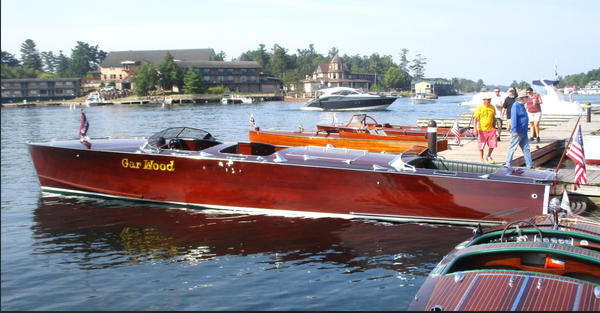The Yacht Edith Boat Line
by: Tom King
During the summer months, back in the “Roaring Twenties,” Clayton was a hive of activity with trainload after trainload of tourists streaming into town to take in the beauty of the Thousand Islands. As a result, the local tourism industry was booming, and many enterprising locals were working hard to cash in on the opportunities to cater to the sightseers. Excursions through the islands on tour boats was an extremely popular attraction, and several new boat lines sprang up during this time, to meet the ever-increasing demand for the tours.
The Yacht Edith Line was one of the new boat lines that was established. In June 1925, a notification printed in The New York Times stated that the Yacht Edith Line of Clayton, Jefferson County, had been incorporated, with a capitalization of $5000. The three principals named in the corporate documents were W.D. Lantier, G.O. Gillick, and O.P. Gillick.
William Lantier was a local real estate developer, George Gillick owned a garage and was Clayton’s Ford dealer, and Owen Gillick, George’s younger brother, was a dentist. William’s wife, Catherine, and George’s wife, Ethel, were also named as directors of the newly formed corporation. Sadly, Catherine Lantier passed away in December of 1925 at the age of fifty-four. In the December 23, 1926, issue of the Cape Vincent Eagle it was reported that Mr. Lantier had purchased “the entire capital stock of the Yacht Edith Line, Inc., together with the valuable real estate holdings including docks and pavilion located on Riverside Drive, in the center of the business of Clayton” from the others involved in the venture.
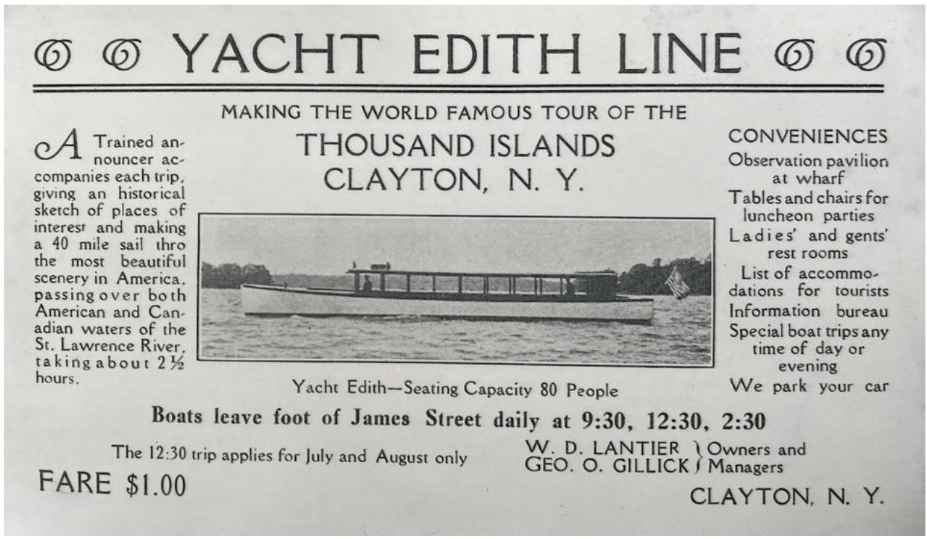
The boat line began with the Yacht Edith, a sixty-footer built in 1924 by the Clayton Ship & Boat Building Corporation, which had a capacity of eighty people. In 1926 a second boat, Edith II, was added. This new boat had a length of almost sixty-five feet, a beam of just over thirteen feet, and could carry one hundred and twenty-five passengers. In 1927, Captain H.G. Gould’s tour boat, Anywhere, joined the fleet. It was reported in the Watertown Daily Standard on June 29, 1927, that the Anywhere would be based in Cape Vincent and run her excursions with forty-four passengers from that port. In 1928, a fourth vessel, Edith III, was launched to help meet the growing demand for excursion capacity. The Edith III was made off the same plans as the Edith II, and they were truly incredibly attractive watercraft. In the May 18, 1928, issue of the Watertown Daily Standard, the latest Edith was described as “one of the finest and most palatial of the island tour boats.” The Clayton Ship & Boat Building Corporation constructed both the Edith II and Edith III.
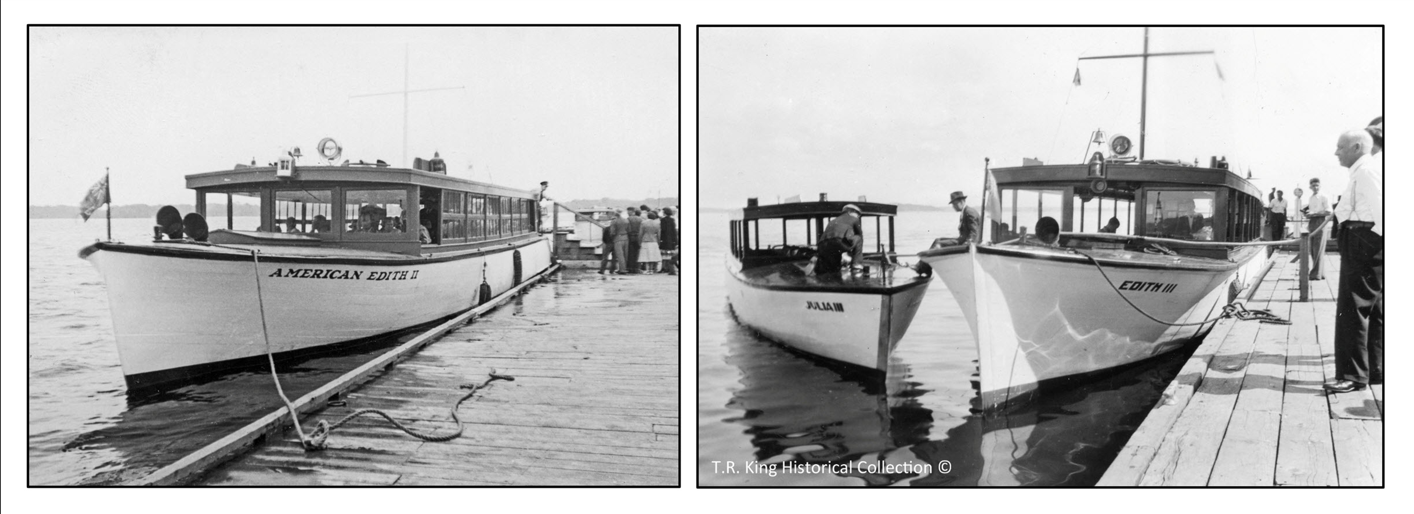
Horace Graeme Gould, affectionately known as Captain “Dud,” was the son of a shipbuilder and spent over forty years as a tour boat captain in the Thousand Islands. He ran tours from Clayton in a relatively small vessel called Anywhere. In 1923, he sold that boat to Capt. Wallace Murdoch and during the following winter built a bigger boat, which he also named Anywhere. Captain Murdoch agreed to change the name of his new boat to avoid any confusion.
Captain “Dud” was famous for the commentary that he gave to his passengers as they cruised through the islands. According to an article in the Watertown Daily Standard, he used to tell the tourists that the reason there were so many islands in the area was because he would put a can of baking powder in the River every so often and a new island would rise as a result, since baking powder will make just about anything rise. The newspaper article goes on to say that a baking powder company sent Captain Gould a package of twenty-five assorted products.
Many of his humourous stories were published in a small paperback book named ‘Round the Islands with Capt. “Dud” Gould', which could be bought from the Yacht Edith Line for twenty-five cents.
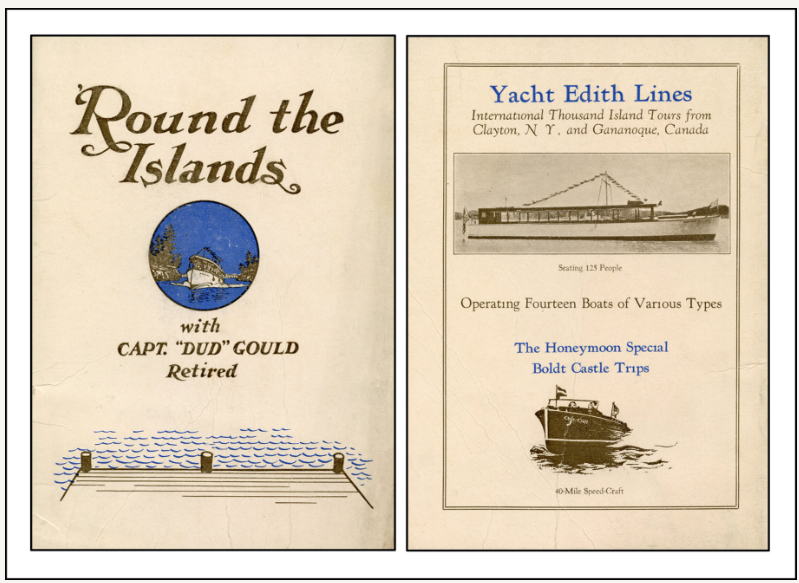
In the spring of 1927, Mr. Lantier diversified his holdings by purchasing the property of the Clayton Ship & Boat Building Corporation on Theresa Street. He set about transforming the property by creating a sand beach on part of the shoreline. He erected thirty bathing huts and had over one hundred truck loads of sand brought in for the beach. Mr. Lantier also had several large docks, and a breakwater built at the site. In addition, he constructed some covered boathouses in which the Yacht Edith Line tour boats could be kept. Unfortunately, before the beach could be opened for the 1929 season, high winds and water levels swept all the sand out into the bay and the plans for the community swimming spot were abandoned.
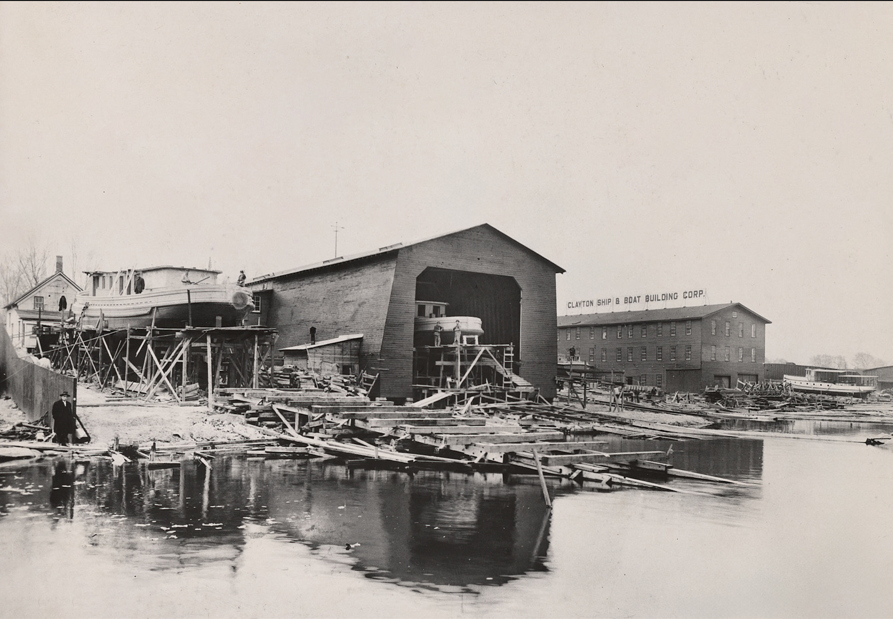
By the late twenties there were many different boat lines operating out of Clayton, some doing better than others. The Brown Boat Line had been taken over by the bank due to insolvency and the financial institution was looking for a buyer to take the business over. It was stated in the July 18, 1929, edition of the Sandy Creek News that Stewart Ormsby, a local businessman with interests in dairy farming and a crushed stone operation, was approached about buying the struggling boat line. After reviewing the situation, Mr. Ormsby decided not to buy the one line, but that he would amalgamate the Clayton boat line industry by purchasing several of them. According to the story, Mr. Ormsby had individual sales agreements drawn up and then had his representatives meet with each of the boat line owners at the same time, to get the deal done. Within two hours all the paperwork had been completed, and the businesses had been transferred to Mr. Ormsby.
He then approached Mr. W.D. Lantier, the owner of the Yacht Edith Line, with a proposal of combining the newly obtained businesses with the successful Edith line and have Lantier manage the whole operation. An agreement was reached between Ormsby and Lantier and the new venture would continue to be operated under the name Yacht Edith Line. The new company, with a capitalization of $250,000, was structured with Lantier as president, Ormsby as Treasurer, Mrs. Ormsby as Secretary, and a Canadian Vice President, H.F. Ward, holding the Canadian rights, making it an international corporation.
Besides the Yacht Edith Line’s four large tourist craft, the Miss Clayton Line, owned by Haas & Consul, consisting of two boats, and the Spray Line with two more, owned by Cuppernall & Marshall, were part of the merger. Also included were two vessels of the Brown Boat Line, which had recently been seized by a Clayton bank under a mortgage foreclosure. The mail and express that used to be carried by the Brown line would be handled by the new combine. The company’s plans were to maintain a regular schedule of runs between Clayton, Kingston, and Gananoque, as well as providing a fast service across the River with a fleet of speedboats. The new company would also operate the Clayton shipyards, which had been acquired earlier by Mr. Lantier, to construct additional boats, and remodel existing ones, in connection with the new tourist service, beginning the following year.
In the November 7, 1929, edition of the Cape Vincent Eagle it was reported that W.D. Lantier, president of the Yacht Edith Line, had secured Stuart Ormsby’s holdings in the company and now held controlling interest.
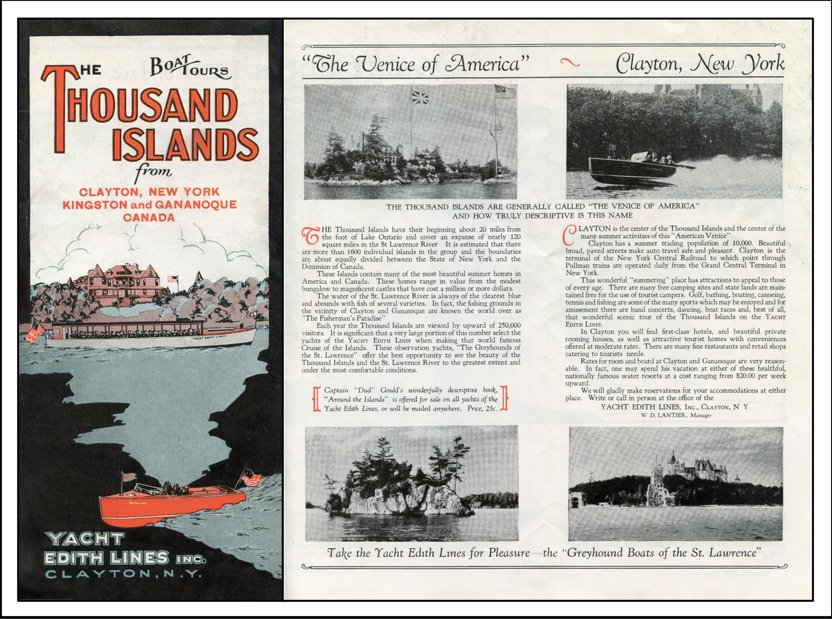
One common element that all these old boat lines seem to share is fire, although the Yacht Edith Line didn’t have any of its vessels burn up. In the early morning hours of July 4, 1931, it was reported that the gasoline stove in Mrs. Kinney’s hot dog stand on Riverside Drive exploded and set fire to the structure. The Syracuse American article went on to state that, in the ensuing excitement, a gallon can of gasoline was knocked over and ignited, feeding an already spreading inferno. After the fire had been extinguished by the Clayton Fire Department, the subsequent site assessment found that two buildings had been destroyed and another two damaged in the $15,000 blaze. Besides the hot dog stand, the Yacht Edith Line pavilion, which included a ticket office, was gutted. The boat line’s offices, in an adjacent building, also suffered serious harm from the fire. Fortunately, the fire fighters were able to contain the flames so that it didn’t totally consume any of the adjacent buildings.
The Great Depression of the early thirties took a severe economic toll on the Clayton tourist industry. Unfortunately, being leveraged with a large amount of debt, the Yacht Edith Line couldn’t service the outstanding mortgages and was forced into bankruptcy in 1934. Ten of the Yacht Edith Line’s boats were sold at a mortgage foreclosure sale, held at the Mercier Shipyard. The March 21,1935, edition of The Kingston Whig Standard listed the boats sold at auction as Edith, Edith II, Edith III, Miss Clayton, Miss Clayton II, Spray VI, Anywhere, Just Brown III, Just Brown IV, and the speedboat, Smiling Thru. All ten were purchased by the recently formed Clayton Independent Boat Line, which was later renamed The Clayton Boat Line.
The bankruptcy proceedings against the Yacht Edith Line also included the real estate holdings of the company. With the passage of the 21st Amendment to the United States Constitution in December of 1933, which ended the prohibition era, the timing was right to open a glamourous night club in the Thousand Islands. Stewart Ormsby, doing business as the Thousand Islands Development Corporation, began renovating the old shipyard building to turn it into a large dinner and dance hall, which would be named the Clayton Casino.
Although it was not a gambling establishment, as the name might suggest, it became an overnight success, attracting big name bands of the era to entertain the crowds of diners and dancers. Mr. Ormsby was only involved with the new entertainment venture for a year before it got caught up in the Yacht Edith Line bankruptcy proceedings.
A well-known vaudeville actor, Cameron C. McNutt, who went by the stage name of “Pop” Cameron, took over the operation for the 1935 season and ran it until his death in 1940. McNutt’s bookkeeper, William P. Cavanaugh, stepped in and managed the business until its closing in 1941, due to the large decline of patrons because of World War II and the associated gasoline rationing.
Later that year, the building was acquired by Ned Hawes, who opened a waxed paper and paper napkin manufacturing facility at that location and operated it until 1951, when he sold the business, and it moved out of Clayton. He then established the Clayton Marina on the site and made extensive improvements to the docking facilities on the waterfront. The large hall that used to house the Casino was used for boat storage. The following year, Harry B. Burr opened a six-lane bowling alley in an unused portion of the building, know as the lean-to, and organized the first bowling league in the area.
In 1956, Mr. Hawes sold his marina business to Tom Turgeon and Howard Johnson, who incorporated under the name Thousand Island Marina. The bowling alley was closed in 1959 due to Mr. Burr’s health issues. From that time, until the building’s demolition in 2008, the facility had been used by the marina for boat storage and repairs.
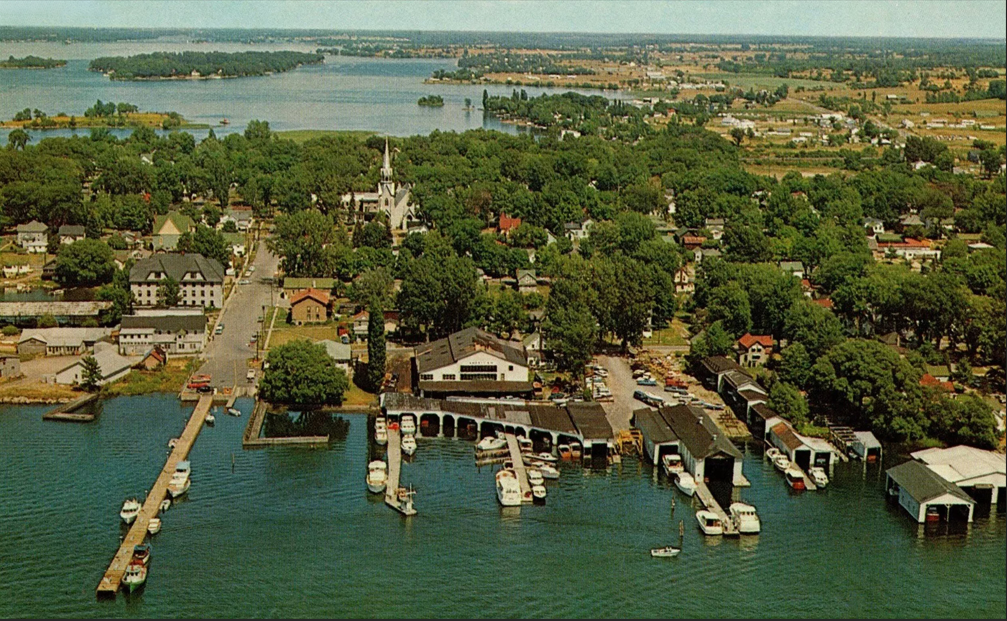
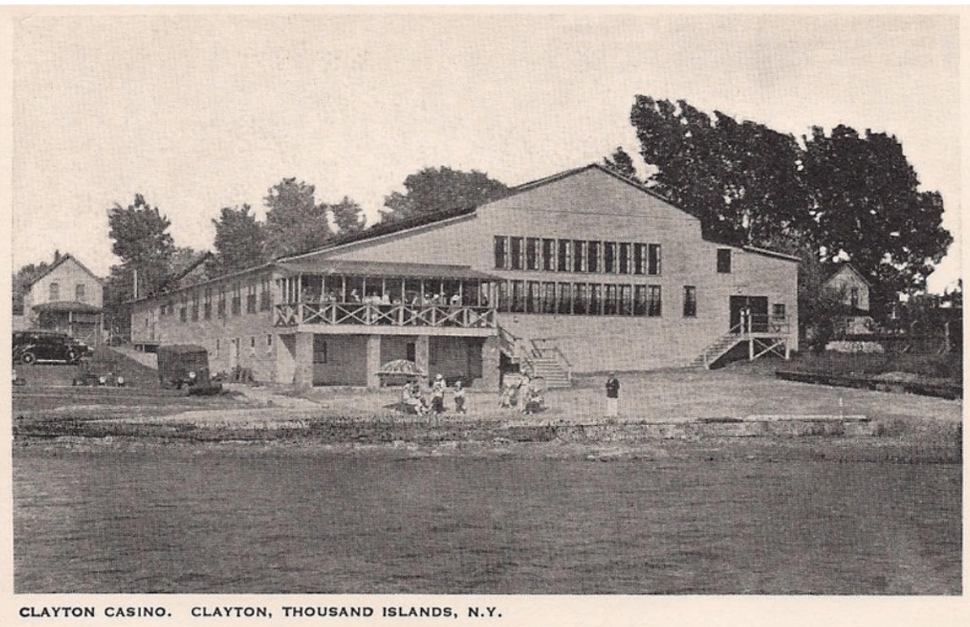
Down, but not out, William Lantier started up a new boat line in 1936, named the 1000 Island Yacht Line. He took possession of the lovely old Gloria III from Jay Gardner and the Just Brown IV, which he renamed Gloria. The line ran several daily tours through the islands from Clayton, with a stopover in Gananoque. In 1945, an old friend joined Mr. Lantier when the Edith II was added to the fleet.


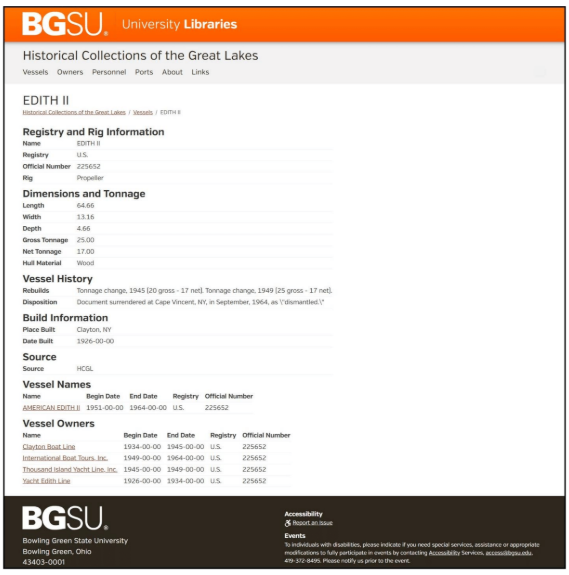
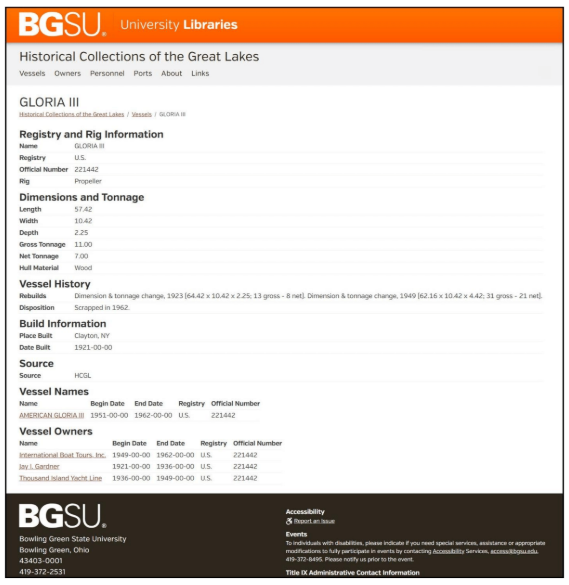
L: The Bowling Green State University Historical Collection of the Great Lakes database entry for the Edith II tour boat – used with permission of BGSU University Libraries; R: The Bowling Green State University Historical Collection of the Great Lakes database entry for the Gloria III tour boat – used with permission of BGSU University Libraries.
In 1946, William Lantier married Margaret Delaney McCormick, the widow of Everett McCormick. Margaret became quite involved with the operation of the boat line and shortly after she arrived on the scene, the business was renamed The American Boat Line. She also wrote a booklet about the Thousand Islands and the highlights of the tour, which was available for the customers to purchase.
An interesting fact about Margaret McCormick is that she was connected to the famous Clayton landmark, McCormick’s Restaurant. Everett and Margaret had two daughters, Mary and Alice. The elder daughter, Mary, married Vincent DeDominicis, who later changed his name to Vincent Dee. It was Vincent, who, along with his mother, Lillian, started up the restaurant in 1946 and named it McCormick’s, after Mary.
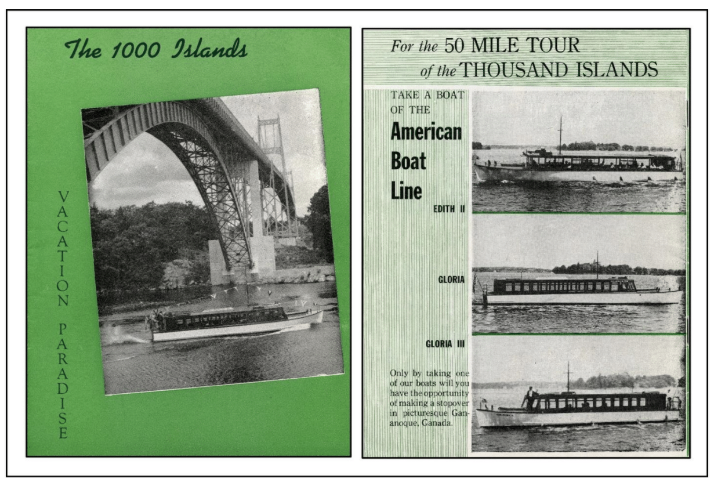
In 1949, with his health failing, W.D. decided it was time to get rid of the boat line. He sold it to Gene Springman, who then partnered with Harry and Gilbert Mercier. Author George Boldt, in his book, Once a Man – Twice a Boy, described the transaction as follows,
“On one snowy February afternoon, Gene Springman on a trip back from Watertown stopped off at Ernie Natali’s Depauville Hotel. He struck up a conversation with Old Will Lantier who offered to sell him the American Boat Line for five thousand dollars. Hands were shaken and then Gene called Harry and Gilbert to offer them one half of the deal.”
The American Boat Line then went on to take over the Clayton Boat Line, but that’s a story for a future article.
William Duford Lantier passed away, at home in Clayton, on November 11,1954, at the age of seventy-nine. He had suffered a lengthy battle with heart disease. William is buried in St. Mary’s Cemetery in Clayton with his first wife, Catherine. An interesting note in Mr. Lantier’s obituary was that he served as Clayton’s mayor in 1918 and 1919 and was also on the town’s Board of Supervisors.
Although the Yacht Edith Line name disappeared around 1947, there is still a reminder of the old boat line precariously holding on to existence in the Thousand Islands. When the American Boat Line deemed that the Edith II was no longer fit for commercial use in 1962, the vessel was purchased by Gerry Russell, the owner of St. Lawrence Dredge and Dock. He transported the old girl over to Wintergreen Island, which he also owned at the time, and made the former excursion boat into a cottage, perched right near the waterfront. Not surprisingly, it was known as The Tour Boat Cottage. Unfortunately, the cottage sustained heavy flood damage during the high-water years of 2017 and 2019. Recent owner, Debbie Green, stated that due to the concerns of mold under the flooring the structure has only been used for storage since that time. Wintergreen Island was sold to new owners last year and it will be interesting to see if they keep one of the few remaining wooden tour boats from the old glory days in existence. Here’s hoping they do!

I would like to thank the following people who assisted with the preparation of this article:
[1] Karen Wand, for sharing her old newspaper clippings from the era with me and for offering her proofreading and editing prowess.
[2] Mark Sprang, the Archivist for the Historical Collections of the Great Lakes at Bowling Green State University, for allowing me to cite the database entries for the Gloria III and the Edith II.
[3] Jordan Coughlin, the Town & Village of Clayton Historian, for providing valuable information on the old Clayton Ship & Boat Building Corporation and the Clayton Casino.
[4] Shannon Buchal, the Archivist at the Antique Boat Museum in Clayton, for allowing me to use the photograph of the Clayton Ship & Boat Building Corporation’s shipyard.
[5] Ken Lantier and Debbie Green for allowing me to use photographs from their personal collections.
By Tom King
Tom King and his wife Marion have lived in Milton, Ontario, for the past 37 years, where they both worked and raised their family of three children: Kris, Mike and Becca. Tom has captured the history of the tour boat industry as well as giving us the best spider story in the past 17 years!
Editor's Note: Read more articles by Tom King here in our new format for TI Life, and more articles on our old site. Thank you, Tom, for your ability to capture the boat line stories of our River has brought history alive!





